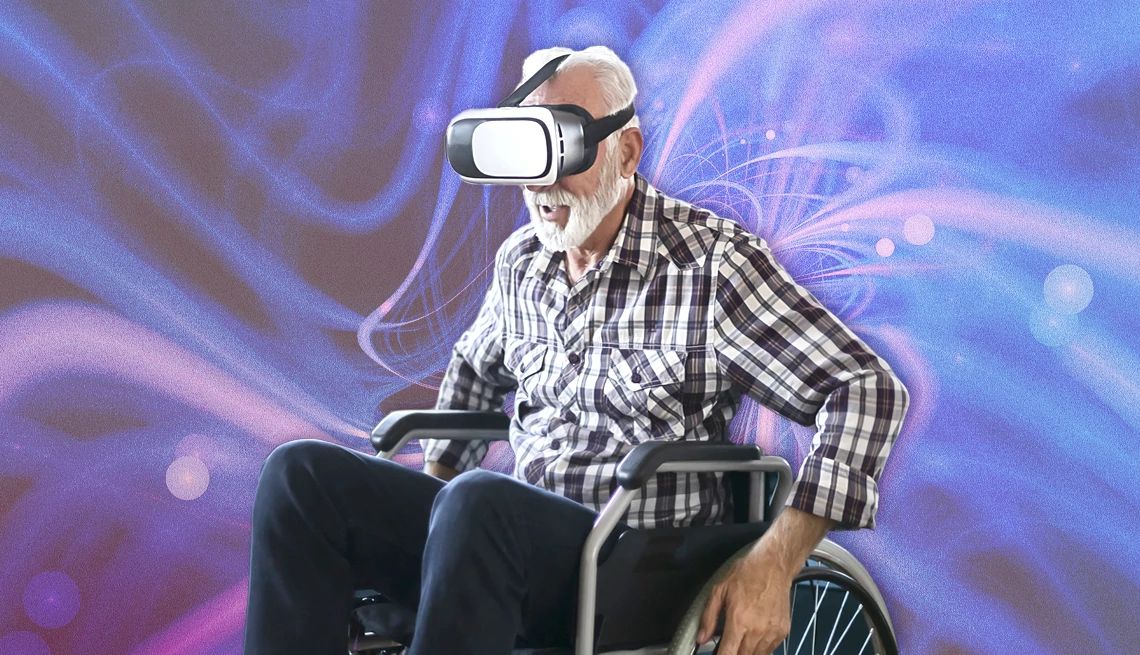AARP Hearing Center


When my father was failing with Alzheimer’s, some of our most tender moments were spent in the car. I’d sign him out of his assisted living facility, and we’d drive past farmland, saltbox homes and cranberry bogs outside Boston. Conversation was limited, but then I’d slip in a Frank Sinatra CD and watch his entire being change as the music entered his brain. A smile moved across his face, his shoulders relaxed, and with both feet tapping, he seemed transported to a 1950’s high school dance in Ridgewood, New Jersey.
Today’s caregivers can help their loved ones have a similarly immersive experience using virtual reality (VR) and augmented reality (AR) devices that are designed to elicit positive feelings and, in some cases, reduce stress. The tech doesn’t need to be complex and expensive. Something as simple as a free mindfulness app on a smartphone can offer benefits — for both caregivers and the people they are caring for.
The need for innovative ways to manage the challenges associated with family caregiving is growing.
According to the World Health Organization, the number of people aged 60 and older will double globally by 2050. That means more of us will not only depend on caregivers, but will be caregivers, and not everyone possesses adequate resources and skills, especially for those caring for loved ones who are living with stroke, dementia and other chronic diseases. Day-to-day tasks can feel overwhelming and the “caregiver burden” can manifest in exhaustion, grief, worry, anxiety, self-accusation and depression.
How the tech works
So, what exactly are AR and VR, and how can they help? It’s simple: AR overlays digital elements on reality (usually via a smartphone or AR wearable). VR, on the other hand, is total immersion in a simulated environment with a headset.
Companies like Meta, Google and Apple provide AR/VR products and headsets, like those originally used by the video gaming community, that allow users to visit a favorite place or enter environments that feel familiar. The imagery is realistic enough to make the user feel mentally present, helping them relax and lessen pain.
Shan Padda, 61, founder and CEO of Harvard Medtech, explains that VR can be a powerful tool because it is so distracting. The company’s Vx Therapy headset is prescribed by a clinician and, depending on the patient’s needs, is preloaded with “experiences” to achieve different benefits, with assistance from an in-house “navigator.”
“The patient gets very focused on what they are watching, and their brain is in a hyperfocused state, flooded with audio/visual stimuli to the extent that it deprioritizes the secondary signals of pain, hunger, sorrow, even the need to go to the bathroom,” he explains.
In one test, a patient was reporting an average pain level of eight. In separate tests — one with just a headset and the other with only an opioid — the reported pain dropped from eight to four in both cases, showing the same level of pain reduction without medication.
Padda is excited about the possibilities of VR for people experiencing trauma and pain, depression, poor sleep, PTSD or feelings of isolation and depression, often associated with caregivers. His work began with the military, where community isolation and loneliness is high, with the goal of helping veterans and active-duty military suffering from PTSD achieve changes in the brain through a nonnarcotic pain management method.
































































More From AARP
A Caregiver’s Guide to Smart Home Technology
Living independently as long as possible is the goalHow to Find Streaming TV Shows for Adults With Cognitive Challenges
Whether it’s ‘I Love Lucy’ or classic sports events, TV can elicit waves of warm feelings and even joyHow to Set Boundaries as a Family Caregiver
Sometimes saying ‘no’ is the only answerRecommended for You